ALL TWENTY-TUESDAY: MIAMI TE DAVID NJOKU
The draft stock of David Njoku is a matter of balancing potential and production.
On the side of potential, we’re talking about one of the youngest players in the entire class. Njoku will only be 21 years old by by the start of training camp, which means he’ll only be 24 years old at the end of his rookie contract. That matters because, when you weigh the risk and reward of taking a player in the first round, ideally you’d like to get two contracts out of him, the rest is always a crapshoot fighting against Father Time.

Miami TE David Njoku – Photo by: Getty Images
When you have a player who is either 23 or 24 in their first year in the NFL, their early production is fine, that’s why I have no problem with taking guys like that outside the Top 50, as long as their talent warrants it. But, if instead you draft an older player in the first round, you’re looking at them being 27 or 28 when it’s time to sign them to that second deal. If that’s the case, how much return on your investment are you getting? There’s no guaranteed that the prime of their abilities is still ahead of them for most of that next deal.
When you’re 20 or 21 in your first year in the NFL, there are maturity variables you may have to deal with, but if there is enough talent to warrant a first round selection at such an age, you can expect to see at least good production from half of that first contract, then possibly a great to elite level player for the duration of their second deal. That’s called getting the most bang for your buck, and a reason why players as young and as talented as Njoku are coveted the way they are.
On the flip side, though we’ve seen instances of Njoku’s success on the field, the same size is relatively small. He only started nine out of the 26 games he played (though he was the top-targeted tight end both seasons). Njoku never had more than 50 catches in a single season, nor did he ever accumulate more than 700 yards. He did score eight touchdowns in his final year of playing, but in his first year (his redshirt freshman year) he only had one, so, even though the growth was explosive, production-based evaluators will be wary.
Njoku multiplied his production from year one to year two. Let’s take a look at his growth and see if it’s something that directly translates to the NFL, warranting a possible selection in the first round, or if he’s more of a project than the Bucs would be willing to draft at No. 19.
Athleticism

Let’s just get the obvious right out in the open: Njoku is one heck of an athlete. At his combine, he ran a 4.64, jumped 37.5 inches vertically and broad jumped over 11 feet. That’s evident when you watch him play, which is important. Some players can be athletic in Combine tests, but have a hard time translating that to the football field; Njoku is not one of them.
In the play above, Njoku lines up in as a single-back tight end, which is usually a dead give away that he’s in there to block. Instead, it was a block and release play designed for him that got him open space to run. Njoku not only had the speed to make the defender miss, but also the hops to jump up, over and into the end zone.
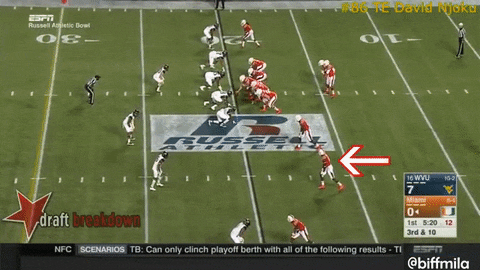
Here’s another look at Njoku’s athleticism, this time from the FLEX tight end position (a name they used to identify tight ends who are lining up as a slot receiver).
Miami likes to get the ball in Njoku’s hands as quickly as they can to allow more time for him to make moves and run past defenders. Normally, screen plays like the one above are designed for much smaller, quicker receivers, but that’s a 6-foot-4 players the Canes have out there doing that. Njoku does a nice job of making the first defender miss, then had the instincts to leap over the second player. If not for the third defender, he might have had the first down.
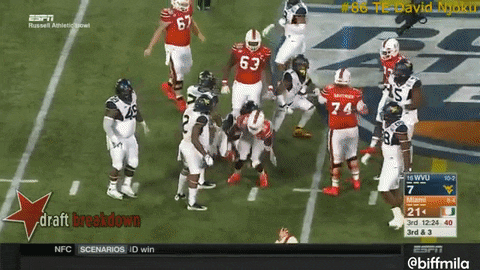
Finally, the play above displays a swing pass to the outside with Njoku again in the FLEX position.
There’s a lot to love about this play. First is his instinct to get his arm out and separate from the defender, which showed he knows how to use his length. The second is obviously his balance and determination to stay on his feet and keep going. The third is him putting that 11-foot broad jump to use with a big leap into the end zone (he likes to do that). There are some things that limit Njoku’s game right now, but being athletic is certainly not one of them – both in ability and instincts to use it.
Blocking
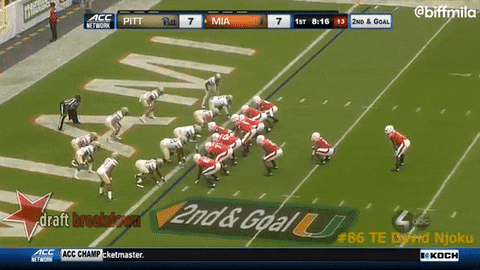
Miami lined up Njoku on the line as a single-back tight end plenty of times this season, so I wouldn’t say that him being there is a liability, but it is something he needs to work on if he’s going to be more than just a FLEX tight end.
The play above shows Njoku’s biggest flaw, to me; his consistency to square up with defensive linemen and linebackers. Njoku has the frame to take on pass rushers and run defenders of all shapes and size out on the edge, but, at times, he has a hard time finding his balance. Most of the time that’s due to players not being fluid out of their stance, or not getting good leverage, but I wouldn’t say that’s the case with Njoku; he does a decent job with that (which is good). At times, he just fails to square up and generate power consistently.
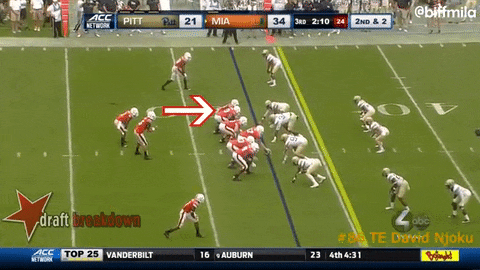
Here’s another example of Njoku failing to be effective with his block.
He goes low to try to take on the aggressive defender, but he doesn’t keep his head up long enough to square up with him and just dives at his legs. The defender, who had not yet committed to a side, threw off Njoku’s attempted block, and was able to help make the tackle a second later.
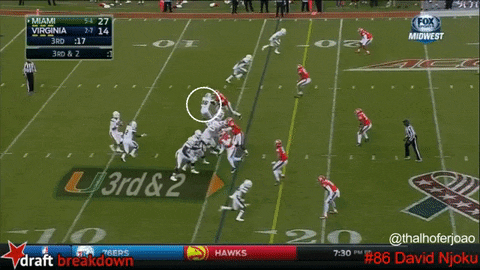
Making sure he squares up to his defender with his long frame is his biggest consistency issue when it comes to blocking. When he squares up, he has the power to hold onto most blocks. However, there are times when going up against more powerful defenders that Njoku can be pushed around.
There aren’t many clips like the one above of Njoku just looking helpless on skates going backwards, but I do think strength is an area of his game he’ll need to add going to the next level. More strength, especially in his lower body, will allow for more leeway when he’s not completely square with his defenders.
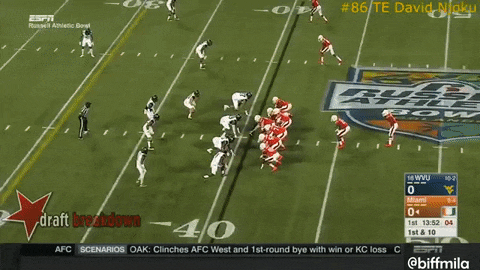
When Njoku does get square with his defenders, he can engulf them like in the clip above. Njoku does a nice job here of recovering from the defenders initial punch (because he was square with him) and had the strength to drive him all the way back and finish the block. He has the length and the frame to be able to take on defenders like in the clip above, but as the players in the NFL get bigger and strong, he will have to as well – and he can, he’s only 20 years old.
Receiving
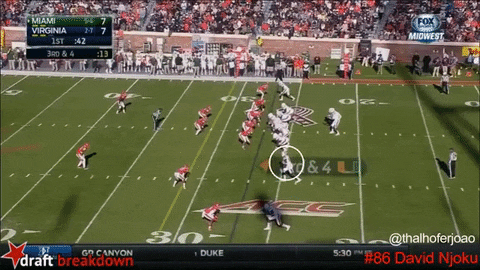
Njoku does most of his receiving work out of the FLEX tight end position, and what I like most about him is how he has a knack for finding the open space when it’s there.
Players who play in the slot have to be excellent and making the most out of space and have to be knowledgable in finding soft spots in zone coverage. This goes for whatever position player that might be from the Antonio Browns to the Rob Gronkowskis. Though Njoku didn’t get the ball in the clip above, he did a good job of faking out the player in front of him, creating hesitation and finding the space on his route over the middle to get by the other defender. If the pass would have gone to him in stride, it would have been a 10 or 15 yard gain.
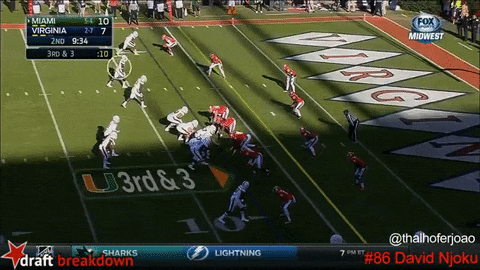
This next play is a perfect example of where that knowledge of soft zones works best.
Njoku’s route in the play above is very unconventional. He’s not running in a straight line by any means, and you can even see him weave his way up and down as he sees where defenders are dropping into coverage. When he noticed that the WILL linebacker was in a shallow zone over the middle to cover the running back, and the SAM linebacker had no help to his right, Njoku move up his route and into the end zone behind the shallow zone and right of the crossing zone to find space and grab the score. That’s a job well done.
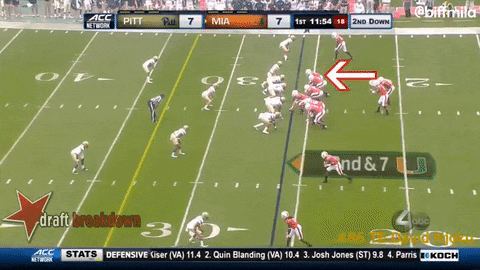
Before I give my last example, I had to show the play above. When Njoku is one the line with his hand in the ground as a single-back tight end, he’s a blocker 80 percent of the time. It’s when he’s in the FLEX position that he does most of his receiving work. But, I’m showing the play above to make sure you’re not discouraged by that first statistic as if Njoku struggles as a receiver from the single-back formation; he doesn’t.
The play above is an ideal example of how the Buccaneers would use Njoku. With Cam Brate on one side and Njoku on the other, the Buccaneers would have at least one mismatch in the middle of the field per play for most teams they face. With head coach Dirk Koetter looking to create more explosive plays in the middle of the field, the play above showed why Njoku is a good, and maybe the best, candidate to do that.

This final play from Njoku is the icing on the cake for him as a receiver.
Though Njoku only had 63 career catches at Miami, he averaged 16.6 yards per catch on those receptions and had a 7-to-1 catch-to-touchdown ratio.
Njoku is a legit red zone threat. As shown in the previous play, he can find open space in the end zone and high point catches (which shows he knows how to use his length, which not all tight ends do), and in the play above, he showed he has the concentration, strength and footwork to get the job done in tight areas, too.
When I look at Njoku, I see a player that is well ahead of his age in terms of athleticism and how to use it. I see a player who has already shown the football IQ to line himself up where ever he needs to be both pre-snap and in his route to be open for catches, and I see a player who is determined to score touchdowns.
When it comes to the 19th overall pick, Njoku does have area of his game he needs to improve on, but, to me, those areas are youth and development related, and not in ways that are affected by character or work ethic. They are areas that will be corrected as he grows.
When scouting a player it’s important to remember that if a player doesn’t show a certain kind of ability in college, it’s foolish to think he’ll suddenly have that in the NFL. Weaknesses don’t disappear, strengths get stronger. That’s what potential is. To me, that’s why I think Njoku has the highest ceiling of any of the tight ends in this historic class. His strengths are more vast than any other tight end prospect.
Trevor Sikkema is the Tampa Bay Buccaneers beat reporter and NFL Draft analyst for PewterReport.com. Sikkema, an alumnus of the University of Florida, has covered both college and professional football for much of his career. As a native of the Sunshine State, when he's not buried in social media, Sikkema can be found out and active, attempting to be the best athlete he never was. Sikkema can be reached at: [email protected]


